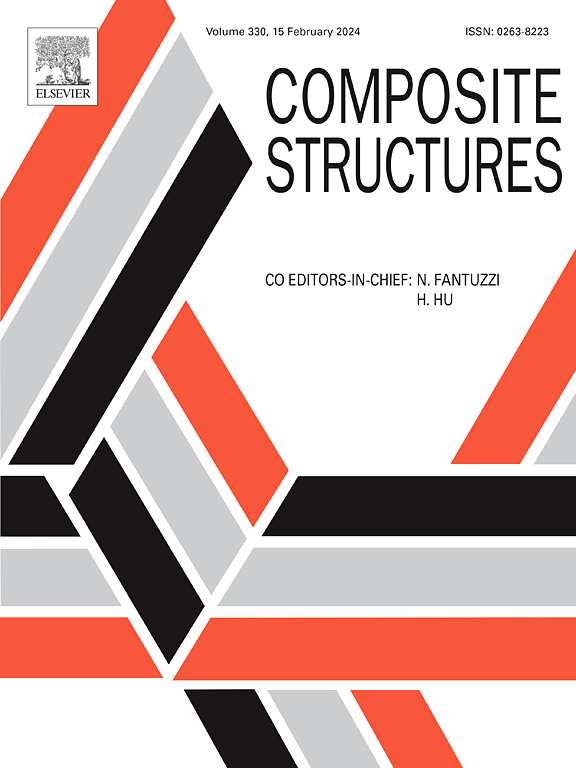Optimization of a macrofiber piezoelectric energy harvester using artificial neural networks
IF 6.3
2区 材料科学
Q1 MATERIALS SCIENCE, COMPOSITES
引用次数: 0
Abstract
This paper addresses the challenge of finding the optimal design parameters for a piezoelectric energy harvester. It presents an advanced simulation-driven optimization approach to determine the optimal geometric and circuit configuration for maximizing energy harvesting efficiency. Additionally, it enhances power output at an excitation frequency within the 10–100 Hz range, which is commonly found in the environment. The harvester consists of a cantilever beam partially coated with a macrofibre composite (MFC) piezoelectric patch, connected to a resistance load and subjected to base excitation. The optimization platform is built upon both analytical and finite element (FE) models of the energy harvesting system. For beams with a large aspect ratio (length/width), the analytical model based on Euler-Bernoulli beam theory is used, while for those with a small aspect ratio, a 3D FE model is employed to simulate the entire energy harvesting process. This approach enhances the accuracy of piezoelectric energy prediction. Due to the high computational cost and the significant time and memory required for running numerous simulations to evaluate the objective function (OF) used in the optimization, a more efficient solution is implemented based on a Neural Networks (NNs) model. Initially, the NNs is trained using a dataset derived from simulations and its performance and accuracy are rigorously assessed through various statistical methods. Once trained, the NNs serves as a surrogate model for OF evaluation, allowing for more efficient black-box optimization via a Genetic Algorithm (GA). Finally, a thorough analysis of the optimal design parameters obtained from the optimization process is conducted.
基于人工神经网络的超光纤压电能量采集器优化设计
本文解决了寻找压电能量采集器的最佳设计参数的挑战。它提出了一种先进的仿真驱动优化方法来确定最优的几何和电路配置,以最大限度地提高能量收集效率。此外,它增强了在10-100 Hz范围内的激励频率下的功率输出,这在环境中是常见的。该收割机由悬臂梁组成,悬臂梁部分涂有巨纤维复合材料(MFC)压电贴片,连接到电阻负载并受到基础激励。该优化平台建立在能量收集系统的解析模型和有限元模型的基础上。对于长宽比较大的光束,采用基于欧拉-伯努利光束理论的解析模型,而对于长宽比较小的光束,采用三维有限元模型模拟能量收集的整个过程。该方法提高了压电能量预测的精度。由于运行大量模拟以评估优化中使用的目标函数(OF)所需的高计算成本和大量时间和内存,因此基于神经网络(NNs)模型实现了更有效的解决方案。最初,神经网络使用模拟数据集进行训练,并通过各种统计方法严格评估其性能和准确性。经过训练后,神经网络作为OF评估的代理模型,允许通过遗传算法(GA)进行更有效的黑盒优化。最后,对优化过程中得到的最优设计参数进行了深入的分析。
本文章由计算机程序翻译,如有差异,请以英文原文为准。
求助全文
约1分钟内获得全文
求助全文
来源期刊

Composite Structures
工程技术-材料科学:复合
CiteScore
12.00
自引率
12.70%
发文量
1246
审稿时长
78 days
期刊介绍:
The past few decades have seen outstanding advances in the use of composite materials in structural applications. There can be little doubt that, within engineering circles, composites have revolutionised traditional design concepts and made possible an unparalleled range of new and exciting possibilities as viable materials for construction. Composite Structures, an International Journal, disseminates knowledge between users, manufacturers, designers and researchers involved in structures or structural components manufactured using composite materials.
The journal publishes papers which contribute to knowledge in the use of composite materials in engineering structures. Papers deal with design, research and development studies, experimental investigations, theoretical analysis and fabrication techniques relevant to the application of composites in load-bearing components for assemblies, ranging from individual components such as plates and shells to complete composite structures.
 求助内容:
求助内容: 应助结果提醒方式:
应助结果提醒方式:


